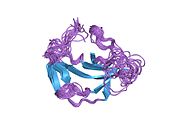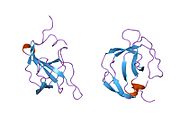Melanoma inhibitory activity
Protein-coding gene in the species Homo sapiens
| MIA | |||||||||||||||||||||||||||||||||||||||||||||||||||
|---|---|---|---|---|---|---|---|---|---|---|---|---|---|---|---|---|---|---|---|---|---|---|---|---|---|---|---|---|---|---|---|---|---|---|---|---|---|---|---|---|---|---|---|---|---|---|---|---|---|---|---|
 | |||||||||||||||||||||||||||||||||||||||||||||||||||
| |||||||||||||||||||||||||||||||||||||||||||||||||||
| Identifiers | |||||||||||||||||||||||||||||||||||||||||||||||||||
| Aliases | MIA, CD-RAP, Melanoma inhibitory activity, MIA SH3 domain containing | ||||||||||||||||||||||||||||||||||||||||||||||||||
| External IDs | OMIM: 601340; MGI: 109615; HomoloGene: 4763; GeneCards: MIA; OMA:MIA - orthologs | ||||||||||||||||||||||||||||||||||||||||||||||||||
| |||||||||||||||||||||||||||||||||||||||||||||||||||
| |||||||||||||||||||||||||||||||||||||||||||||||||||
| |||||||||||||||||||||||||||||||||||||||||||||||||||
| |||||||||||||||||||||||||||||||||||||||||||||||||||
| Wikidata | |||||||||||||||||||||||||||||||||||||||||||||||||||
| |||||||||||||||||||||||||||||||||||||||||||||||||||
Melanoma-derived growth regulatory protein is a protein that in humans is encoded by the MIA gene.[4][5][6]
It is a marker for malignant melanoma.[7]
References
- ^ a b c GRCm38: Ensembl release 89: ENSMUSG00000089661 – Ensembl, May 2017
- ^ "Human PubMed Reference:". National Center for Biotechnology Information, U.S. National Library of Medicine.
- ^ "Mouse PubMed Reference:". National Center for Biotechnology Information, U.S. National Library of Medicine.
- ^ Blesch A, Bosserhoff AK, Apfel R, Behl C, Hessdoerfer B, Schmitt A, Jachimczak P, Lottspeich F, Buettner R, Bogdahn U (Nov 1994). "Cloning of a novel malignant melanoma-derived growth-regulatory protein, MIA". Cancer Res. 54 (21): 5695–701. PMID 7923218.
- ^ Koehler MR, Bosserhoff A, von Beust G, Bauer A, Blesch A, Buettner R, Schlegel J, Bogdahn U, Schmid M (Sep 1996). "Assignment of the human melanoma inhibitory activity gene (MIA) to 19q13.32-q13.33 by fluorescence in situ hybridization (FISH)". Genomics. 35 (1): 265–7. doi:10.1006/geno.1996.0352. PMID 8661134.
- ^ "Entrez Gene: MIA melanoma inhibitory activity".
- ^ Bosserhoff AK, Kaufmann M, Kaluza B, et al. (August 1997). "Melanoma-inhibiting activity, a novel serum marker for progression of malignant melanoma". Cancer Res. 57 (15): 3149–53. PMID 9242442.
Further reading
- Bosserhoff AK, Hein R, Bogdahn U, Buettner R (1996). "Structure and promoter analysis of the gene encoding the human melanoma-inhibiting protein MIA". J. Biol. Chem. 271 (1): 490–5. doi:10.1074/jbc.271.1.490. PMID 8550608.
- Stoll R, Renner C, Zweckstetter M, et al. (2001). "The extracellular human melanoma inhibitory activity (MIA) protein adopts an SH3 domain-like fold". EMBO J. 20 (3): 340–9. doi:10.1093/emboj/20.3.340. PMC 133488. PMID 11157741.
- Lougheed JC, Holton JM, Alber T, et al. (2001). "Structure of melanoma inhibitory activity protein, a member of a recently identified family of secreted proteins". Proc. Natl. Acad. Sci. U.S.A. 98 (10): 5515–20. Bibcode:2001PNAS...98.5515L. doi:10.1073/pnas.091601698. PMC 33244. PMID 11331761.
- Lougheed JC, Domaille PJ, Handel TM (2002). "Solution structure and dynamics of melanoma inhibitory activity protein". J. Biomol. NMR. 22 (3): 211–23. doi:10.1023/A:1014961408029. PMID 11991352. S2CID 8265482.
- Hau P, Apfel R, Wiese P, et al. (2002). "Melanoma-inhibiting activity (MIA/CD-RAP) is expressed in a variety of malignant tumors of mainly neuroectodermal origin". Anticancer Res. 22 (2A): 577–83. PMID 12014625.
- Hau P, Wise P, Bosserhoff AK, et al. (2002). "Cloning and characterization of the expression pattern of a novel splice product MIA (splice) of malignant melanoma-derived growth-inhibiting activity (MIA/CD-RAP) [corrected]". J. Invest. Dermatol. 119 (3): 562–9. doi:10.1046/j.1523-1747.2002.00501.x. PMID 12230496.
- Strausberg RL, Feingold EA, Grouse LH, et al. (2003). "Generation and initial analysis of more than 15,000 full-length human and mouse cDNA sequences". Proc. Natl. Acad. Sci. U.S.A. 99 (26): 16899–903. Bibcode:2002PNAS...9916899M. doi:10.1073/pnas.242603899. PMC 139241. PMID 12477932.
- Poser I, Golob M, Buettner R, Bosserhoff AK (2003). "Upregulation of HMG1 leads to melanoma inhibitory activity expression in malignant melanoma cells and contributes to their malignancy phenotype". Mol. Cell. Biol. 23 (8): 2991–8. doi:10.1128/MCB.23.8.2991-2998.2003. PMC 152547. PMID 12665595.
- Callejo SA, Marshall JC, Cools-Lartigue J, et al. (2005). "Macrophage-derived soluble factor enhances melanoma inhibitory activity expression by uveal melanoma cells in vitro". Melanoma Res. 14 (2): 91–5. doi:10.1097/00008390-200404000-00003. PMID 15057037. S2CID 1429873.
- Marr DG, Poser I, Shellman YG, et al. (2005). "Ultraviolet radiation induces release of MIA: a new mechanism for UVR-induced progression of melanoma". Int. J. Oncol. 25 (1): 105–11. doi:10.3892/ijo.25.1.105. PMID 15201995.
- Poser I, Tatzel J, Kuphal S, Bosserhoff AK (2005). "Functional role of MIA in melanocytes and early development of melanoma". Oncogene. 23 (36): 6115–24. doi:10.1038/sj.onc.1207797. PMID 15208686.
- Zhang Z, Henzel WJ (2005). "Signal peptide prediction based on analysis of experimentally verified cleavage sites". Protein Sci. 13 (10): 2819–24. doi:10.1110/ps.04682504. PMC 2286551. PMID 15340161.
- Jachimczak P, Apfel R, Bosserhoff AK, et al. (2004). "Inhibition of immunosuppressive effects of melanoma-inhibiting activity (MIA) by antisense techniques". Int. J. Cancer. 113 (1): 88–92. doi:10.1002/ijc.20549. PMID 15386421. S2CID 43308803.
- Gerhard DS, Wagner L, Feingold EA, et al. (2004). "The status, quality, and expansion of the NIH full-length cDNA project: the Mammalian Gene Collection (MGC)". Genome Res. 14 (10B): 2121–7. doi:10.1101/gr.2596504. PMC 528928. PMID 15489334.
- Hau P, Ruemmele P, Kunz-Schughart LA, et al. (2005). "Expression levels of melanoma inhibitory activity correlate with time to progression in patients with high-grade glioma". Oncol. Rep. 12 (6): 1355–64. doi:10.3892/or.12.6.1355. PMID 15547763.
- Tatzel J, Poser I, Schroeder J, Bosserhoff AK (2005). "Inhibition of melanoma inhibitory activity (MIA) expression in melanoma cells leads to molecular and phenotypic changes". Pigment Cell Res. 18 (2): 92–101. doi:10.1111/j.1600-0749.2005.00212.x. PMID 15760338.
- Aung PP, Oue N, Mitani Y, et al. (2006). "Systematic search for gastric cancer-specific genes based on SAGE data: melanoma inhibitory activity and matrix metalloproteinase-10 are novel prognostic factors in patients with gastric cancer". Oncogene. 25 (17): 2546–57. doi:10.1038/sj.onc.1209279. PMID 16331256.
- Cao MG, Auge JM, Molina R, et al. (2007). "Melanoma inhibiting activity protein (MIA), beta-2 microglobulin and lactate dehydrogenase (LDH) in metastatic melanoma". Anticancer Res. 27 (1B): 595–9. PMID 17348447.
- v
- t
- e
PDB gallery
-
 1hjd: MELANOMA INHIBITORY ACTIVITY (MIA) PROTEIN
1hjd: MELANOMA INHIBITORY ACTIVITY (MIA) PROTEIN -
 1i1j: STRUCTURE OF MELANOMA INHIBITORY ACTIVITY PROTEIN: A MEMBER OF A NEW FAMILY OF SECRETED PROTEINS
1i1j: STRUCTURE OF MELANOMA INHIBITORY ACTIVITY PROTEIN: A MEMBER OF A NEW FAMILY OF SECRETED PROTEINS -
 1k0x: Solution Structure of Melanoma Inhibitory Activity Protein
1k0x: Solution Structure of Melanoma Inhibitory Activity Protein
 | This protein-related article is a stub. You can help Wikipedia by expanding it. |
- v
- t
- e

















